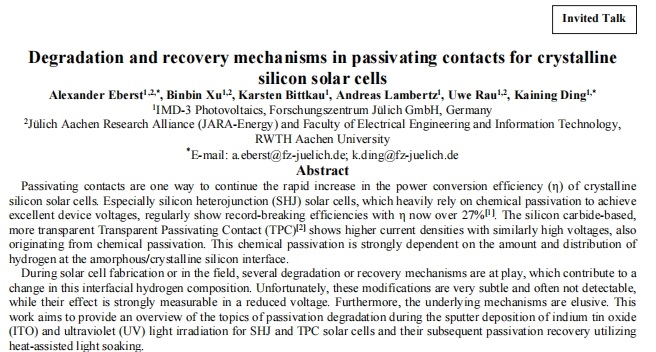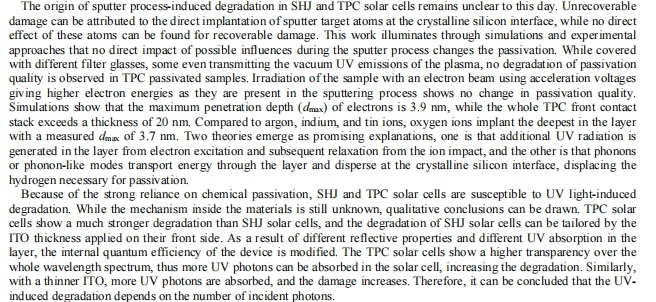| Degradation and recovery mechanisms in passivating contacts for crystalline silicon solar cells 【Alexander Eberst】 |
| 发布时间:2024-10-16 | 浏览次数:315 |
Degradation and recovery mechanisms in passivating contacts for crystalline silicon solar cells Alexander Eberst1,2,*, Binbin Xu1,2, Karsten Bittkau1, Andreas Lambertz1, Uwe Rau1,2, Kaining Ding1,* 1IMD-3 Photovoltaics, Forschungszentrum Jülich GmbH, Germany 2Jülich Aachen Research Alliance (JARA-Energy) and Faculty of Electrical Engineering and Information Technology, RWTH Aachen University *E-mail: a.eberst@fz-juelich.de; k.ding@fz-juelich.de Abstract Passivating contacts are one way to continue the rapid increase in the power conversion efficiency (η) of crystalline silicon solar cells. Especially silicon heterojunction (SHJ) solar cells, which heavily rely on chemical passivation to achieve excellent device voltages, regularly show record-breaking efficiencies with η now over 27%[1]. The silicon carbide-based, more transparent Transparent Passivating Contact (TPC)[2] shows higher current densities with similarly high voltages, also originating from chemical passivation. This chemical passivation is strongly dependent on the amount and distribution of hydrogen at the amorphous/crystalline silicon interface. During solar cell fabrication or in the field, several degradation or recovery mechanisms are at play, which contribute to a change in this interfacial hydrogen composition. Unfortunately, these modifications are very subtle and often not detectable, while their effect is strongly measurable in a reduced voltage. Furthermore, the underlying mechanisms are elusive. This work aims to provide an overview of the topics of passivation degradation during the sputter deposition of indium tin oxide (ITO) and ultraviolet (UV) light irradiation for SHJ and TPC solar cells and their subsequent passivation recovery utilizing heat-assisted light soaking. The origin of sputter process-induced degradation in SHJ and TPC solar cells remains unclear to this day. Unrecoverable damage can be attributed to the direct implantation of sputter target atoms at the crystalline silicon interface, while no direct effect of these atoms can be found for recoverable damage. This work illuminates through simulations and experimental approaches that no direct impact of possible influences during the sputter process changes the passivation. While covered with different filter glasses, some even transmitting the vacuum UV emissions of the plasma, no degradation of passivation quality is observed in TPC passivated samples. Irradiation of the sample with an electron beam using acceleration voltages giving higher electron energies as they are present in the sputtering process shows no change in passivation quality. Simulations show that the maximum penetration depth (dmax) of electrons is 3.9 nm, while the whole TPC front contact stack exceeds a thickness of 20 nm. Compared to argon, indium, and tin ions, oxygen ions implant the deepest in the layer with a measured dmax of 3.7 nm. Two theories emerge as promising explanations, one is that additional UV radiation is generated in the layer from electron excitation and subsequent relaxation from the ion impact, and the other is that phonons or phonon-like modes transport energy through the layer and disperse at the crystalline silicon interface, displacing the hydrogen necessary for passivation. Because of the strong reliance on chemical passivation, SHJ and TPC solar cells are susceptible to UV light-induced degradation. While the mechanism inside the materials is still unknown, qualitative conclusions can be drawn. TPC solar cells show a much stronger degradation than SHJ solar cells, and the degradation of SHJ solar cells can be tailored by the ITO thickness applied on their front side. As a result of different reflective properties and different UV absorption in the layer, the internal quantum efficiency of the device is modified. The TPC solar cells show a higher transparency over the whole wavelength spectrum, thus more UV photons can be absorbed in the solar cell, increasing the degradation. Similarly, with a thinner ITO, more UV photons are absorbed, and the damage increases. Therefore, it can be concluded that the UV-induced degradation depends on the number of incident photons. Lastly, both types of degradation can be recovered by heat-assisted light soaking. Neither the application of only temperature nor high-intensity illumination shows strong effects. While temperature enables the movement of hydrogen inside the layer, it is still bound in the material network of the front contact material. Furthermore, the illumination generates electron-hole pairs, which recombine in the front contact material or at the crystalline silicon interface. The energy released from recombination breaks silicon-hydrogen bonds in the front contact materials and releases hydrogen. However, this released hydrogen is then unable to move to the crystalline silicon interface for passivation. Concluding from this, only the combined effect of high-intensity illumination, together with increased sample temperatures, can release hydrogen in the front contact materials and enable its movement towards the crystalline silicon interface, passivating its dangling bonds, and increasing the passivation quality. References: [1] LONGi Sets a New World Record of 27.09% for the Efficiency of Silicon Heterojunction Back-Contact (HBC) Solar Cells. [2] M. Köhler, et al., Nature Energy 2021, 6, 529.
|








